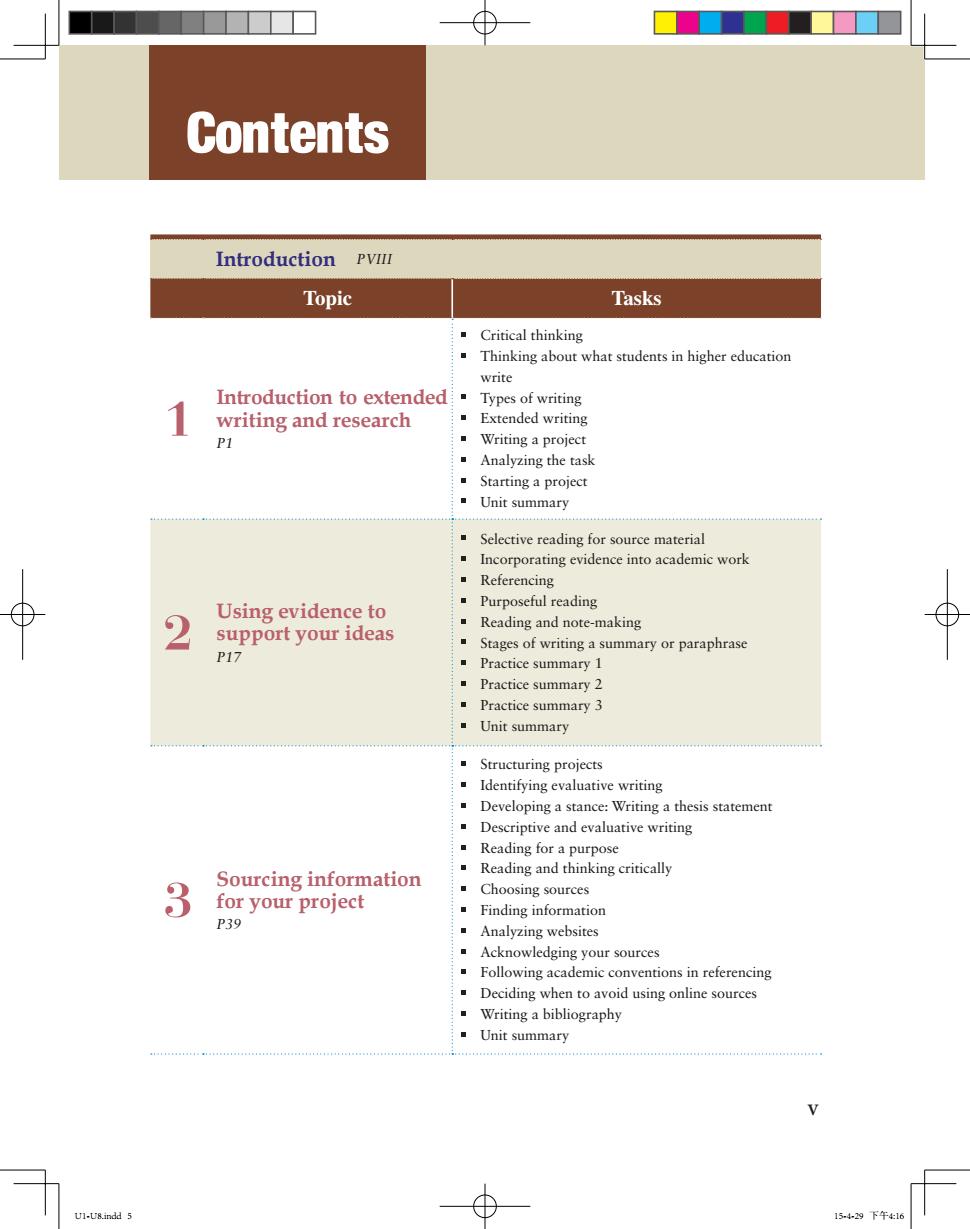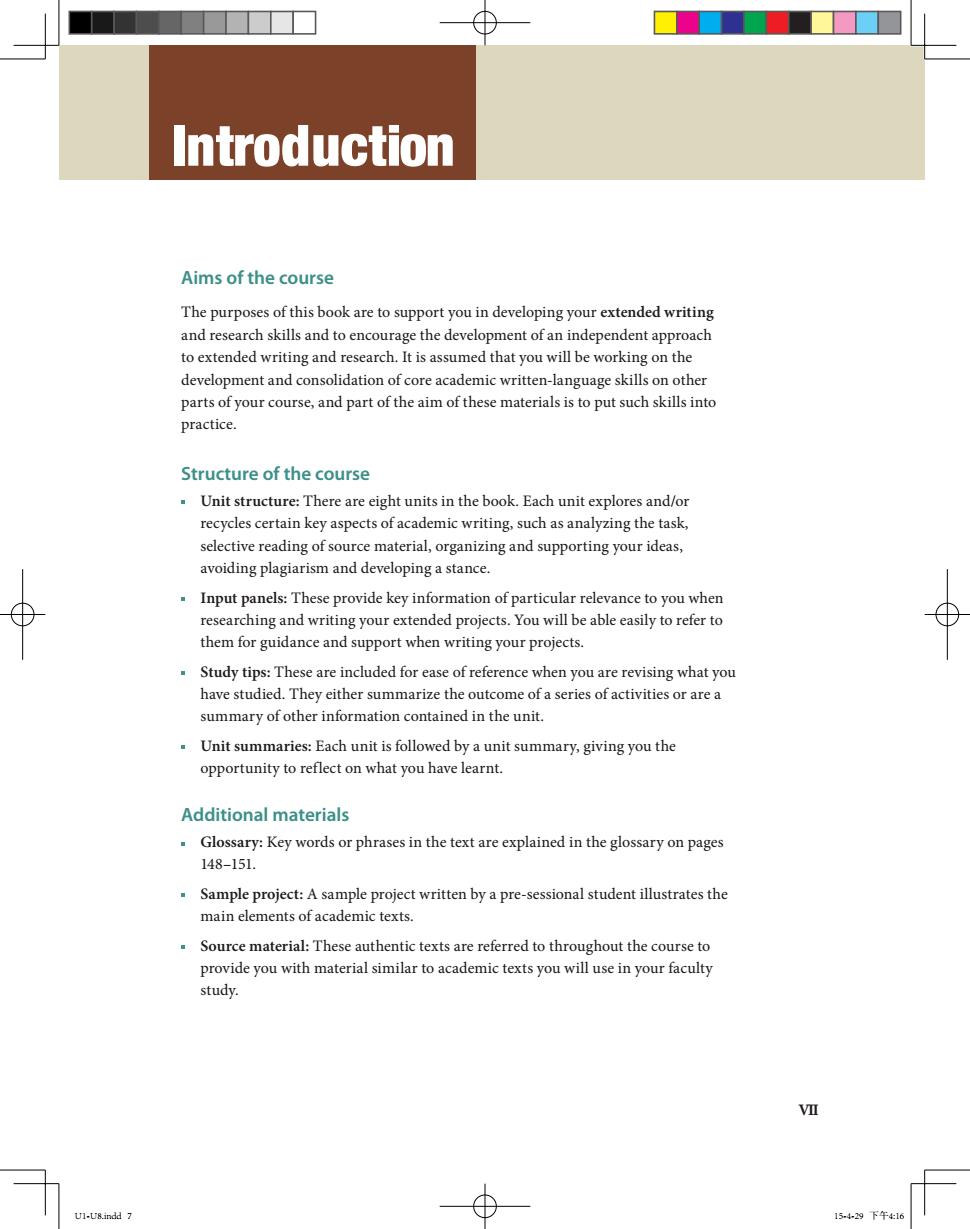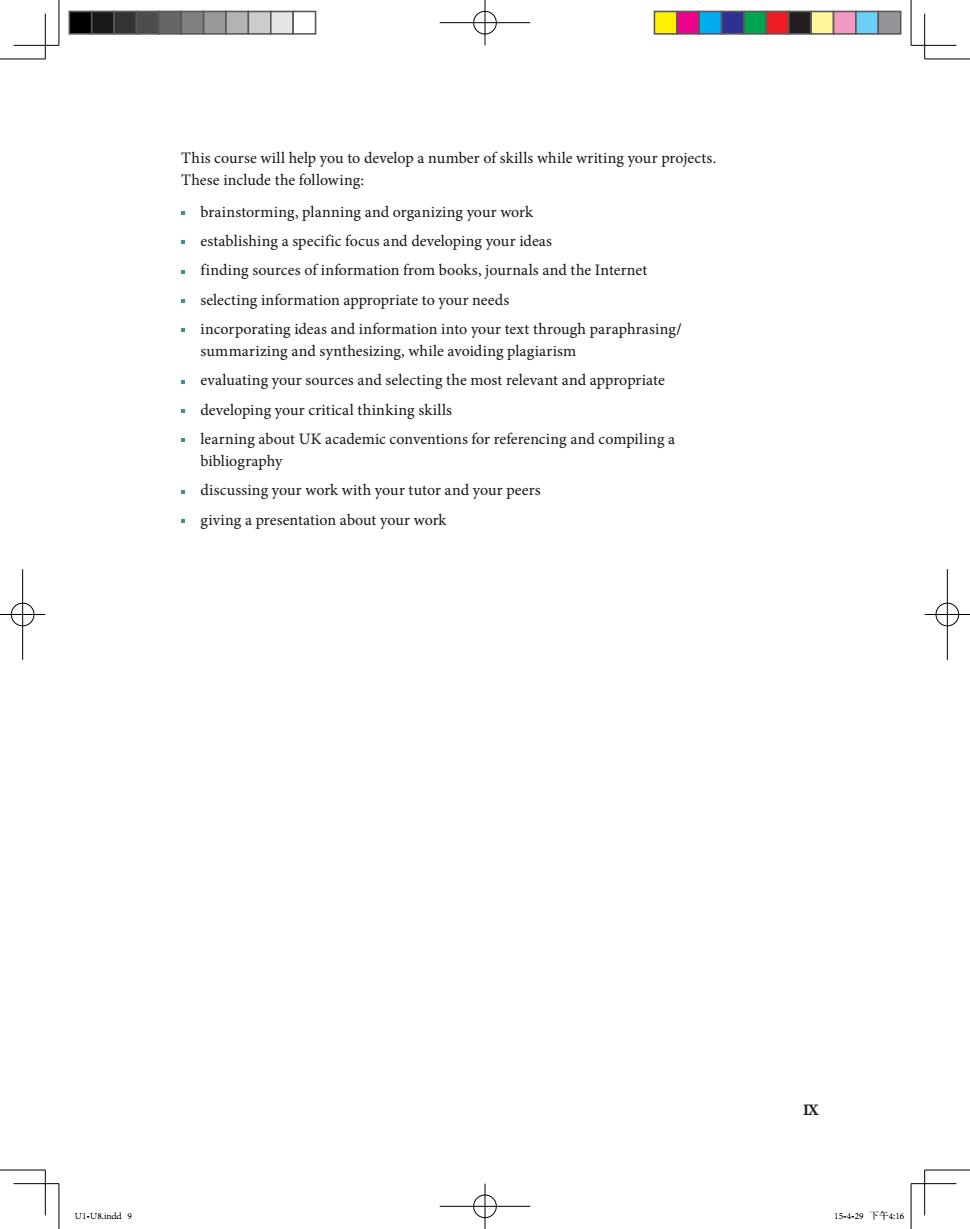
Contents Introduction Pvu Topic Tasks ■Critical thinking Thinking about what students in higher education write Introduction to extended Types of writing writing and research ■Extended writing P1 ■Writing a project ■Analyzing the task Starting a project Unit summary Selective reading for source material Incorporating evidence into academic work ■Referencing Using evidence to Purposeful reading support your ideas Reading and note-making Stages of writing a summary or paraphrase P17 Practice summary1 。Practice summary2 ■Practice summary3 Unit summary Structuring projects Identifying evaluative writing Developing a stance:Writing a thesis statement Descriptive and evaluative writing ■Reading for a purpose Sourcing information Reading and thinking critically 3 ■Choosing sources for your project 。Finding information P39 ■Analyzing websites Acknowledging your sources Following academic conventions in referencing Deciding when to avoid using online sources Writing a bibliography ■Unit summary 4 U1-U8.indd 5 15429下午416
V Introduction PVIII Topic Tasks 1 Introduction to extended writing and research P1 Critical thinking Thinking about what students in higher education write Types of writing Extended writing Writing a project Analyzing the task Starting a project Unit summary 2 Using evidence to support your ideas P17 Selective reading for source material Incorporating evidence into academic work Referencing Purposeful reading Reading and note-making Stages of writing a summary or paraphrase Practice summary 1 Practice summary 2 Practice summary 3 Unit summary 3 Sourcing information for your project P39 Structuring projects Identifying evaluative writing Developing a stance: Writing a thesis statement Descriptive and evaluative writing Reading for a purpose Reading and thinking critically Choosing sources Finding information Analyzing websites Acknowledging your sources Following academic conventions in referencing Deciding when to avoid using online sources Writing a bibliography Unit summary Contents U1-U8.indd 5 15-4-29 下午4:16

X ses and plagiarism Avoiding plagiarism ith absr act 5 Developing a focus P81 。Establishi rking title Unit su ction Introductions, Anapine youe 6 conclusions and definitions P91 The ang yzing you ion The purpose of data Incorporating data and The language for incorporating data 7 illustrations Assessing and interpreting data Working with data P117 Identifying the features of abstracts Preparing for Conference abstracts 8 conference presentations P131 ring a poster presentation Unit summary g Glossary P148 In-U8-5 1549下午ei6
VI 4 Developing your project P65 Preparing for tutorials Quotations, paraphrases and plagiarism Avoiding plagiarism Working with abstracts Unit summary 5 Developing a focus P81 Choosing a topic for your extended essay Developing a topic Establishing a focus Establishing a working title Planning Project 2 Unit summary 6 Introductions, conclusions and definitions P91 Features of introductions Analyzing your introduction The language of introductions Identifying the thesis statement Features of conclusions Analyzing your conclusion The language of conclusions Features of definitions Unit summary 7 Incorporating data and illustrations P117 The purpose of data The language for incorporating data Assessing and interpreting data Working with data Incorporating references in a text Unit summary 8 Preparing for conference presentations P131 Identifying the features of abstracts Conference abstracts Preparing an oral presentation Editing your presentation slides Preparing a poster presentation Editing your written work Unit summary g Glossary P148 U1-U8.indd 6 15-4-29 下午4:16

Introduction Aims of the course The purposes of this book are to support you in developing your extended writing and research skills and to encourage the development or an independent approach practice. Structure of the course Unit structure:There are eight units in the book.Each unit explores and/or recycles certain key aspects of academic writing,such as analyzing the task selectrereadingofso ematerial,organizing and supporting your ideas, avoiding plagiarism and. Inpu panes These provide of rlev. anc nded projects You will be them for guidance and support when writing your projects. summary of other information contained in the unit Unit summaries:Each unit is followed by a unit summary.giving you the opportunity to reflect on what you have learnt. Additional materials Glossary:Key words or phrases in the text are explained in the glossary on pages 148-151. Sample project:A sample project written by a pre-sessional student illustrates the main elements of academic texts. Source material:These authentic texts are referred to throughout the course to provide you with material similar to academic texts you will use in your faculty study
VII Introduction Aims of the course The purposes of this book are to support you in developing your extended writing and research skills and to encourage the development of an independent approach to extended writing and research. It is assumed that you will be working on the development and consolidation of core academic written-language skills on other parts of your course, and part of the aim of these materials is to put such skills into practice. Structure of the course Unit structure: There are eight units in the book. Each unit explores and/or recycles certain key aspects of academic writing, such as analyzing the task, selective reading of source material, organizing and supporting your ideas, avoiding plagiarism and developing a stance. Input panels: These provide key information of particular relevance to you when researching and writing your extended projects. You will be able easily to refer to them for guidance and support when writing your projects. Study tips: These are included for ease of reference when you are revising what you have studied. They either summarize the outcome of a series of activities or are a summary of other information contained in the unit. Unit summaries: Each unit is followed by a unit summary, giving you the opportunity to reflect on what you have learnt. Additional materials Glossary: Key words or phrases in the text are explained in the glossary on pages 148–151. Sample project: A sample project written by a pre-sessional student illustrates the main elements of academic texts. Source material: These authentic texts are referred to throughout the course to provide you with material similar to academic texts you will use in your faculty study. U1-U8.indd 7 15-4-29 下午4:16

Working with the course The book is designed around a ten-week course,during which you are expected to write two projects:a guided project in the first four weeks,and a project in your own academic subject over the remaining six weeks.You will be working on the projects at the same time as you carry out the tasks in cach unit of this book. There is a suggested route through the materials for a shorter course of,for example six weeks.In e,y encouraged tostudy the materias that are not covere .Project work:The course is designed so that for Project 1,the whole group be working on the same essay title,which is provided in the book along with appropriate source material.Your teacher will support you in planning and writing this project,which will enable you to develop the skills you need for extended academic writing.Alternatively,especially on a short course,your teacher might choose to go straight to Project 2(see page8). In academic life at university,students are expected to work independently,and in Project 2 this ct is cm phasized.With the se d project,you own resources,you will,of course,be supported in class and in tutorials during this period.For example,you will be able to"negotiate"a title in collaboration with your tutor and make changes to your project after discussing your work with him/her at various stages of the project. The differences between Project 1 and Project 2 Project2 Title Specified in textbool Title Your choice of topic in your subject area Length About 1.200 words Length 2.000-3,000 vords Resources Mostly provided in the book Resources You need to find your own A lot of support provided Working more Support in the book and by your Support independently.with teacher tutorials 5.29下午16
VIII Working with the course The book is designed around a ten-week course, during which you are expected to write two projects: a guided project in the first four weeks, and a project in your own academic subject over the remaining six weeks. You will be working on the projects at the same time as you carry out the tasks in each unit of this book. There is a suggested route through the materials for a shorter course of, for example, six weeks. In this case, you are encouraged to study the materials that are not covered on your course, independently. Project work: The course is designed so that for Project 1, the whole group will be working on the same essay title, which is provided in the book along with appropriate source material. Your teacher will support you in planning and writing this project, which will enable you to develop the skills you need for extended academic writing. Alternatively, especially on a short course, your teacher might choose to go straight to Project 2 (see page 8). In academic life at university, students are expected to work independently, and in Project 2 this aspect is emphasized. With the second project, you have to choose your own title and decide on the focus of the project. Although you will need to find your own resources, you will, of course, be supported in class and in tutorials during this period. For example, you will be able to “negotiate” a title in collaboration with your tutor and make changes to your project after discussing your work with him/her at various stages of the project. The differences between Project 1 and Project 2 Project 1 Project 2 Title Specified in textbook Title Your choice of topic in your subject area Length About 1,200 words Length 2,000–3,000 words Resources Mostly provided in the book Resources You need to find your own Support A lot of support provided in the book and by your teacher Support Working more independently, with tutorials U1-U8.indd 8 15-4-29 下午4:16

■ This course will help ese incudo to develop a number of skills while writing your proe brainstorming.planning and organizing your work .establishing a specific focus and developing your ideas finding sources of information from books,journals and the Internet selecting information appropriate to your needs incorporating ideas and information into your text through paraphrasing/ summarizing and synthesizing.while avoiding plagiarism .evaluating your sources and selecting the most relevant and appropriate .developing your critical thinking skills .learning about Uk academic conventions for referencing and compiling a bibliography discussing your work with your tutor and your peers giving a presentation about your work Φ K .d
IX This course will help you to develop a number of skills while writing your projects. These include the following: brainstorming, planning and organizing your work establishing a specific focus and developing your ideas finding sources of information from books, journals and the Internet selecting information appropriate to your needs incorporating ideas and information into your text through paraphrasing/ summarizing and synthesizing, while avoiding plagiarism evaluating your sources and selecting the most relevant and appropriate developing your critical thinking skills learning about UK academic conventions for referencing and compiling a bibliography discussing your work with your tutor and your peers giving a presentation about your work U1-U8.indd 9 15-4-29 下午4:16